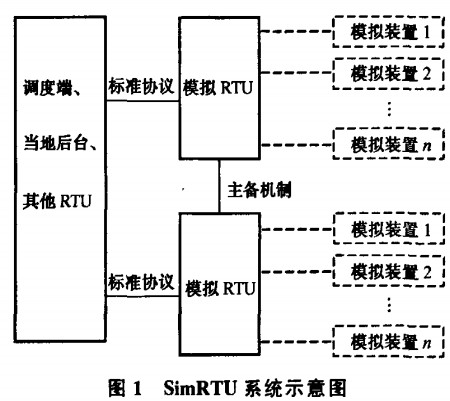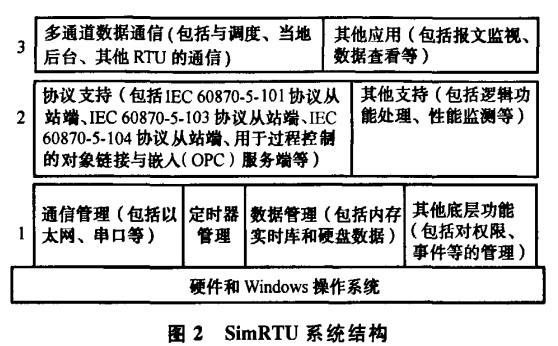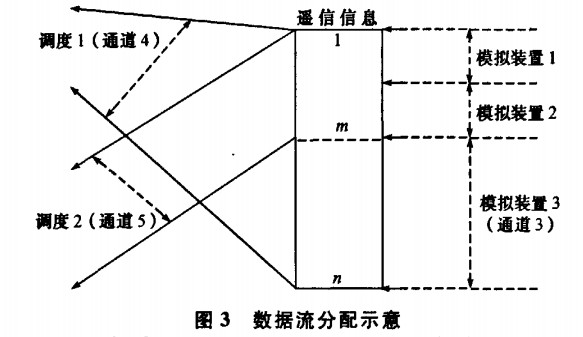The simulation of test environment and test device plays an important role in R & D and testing. At present, the structural characteristics of plant and station automation system based on network, open, layered and distributed and the development trend of digital substation construction in the future make it possible to develop a general simulation device. This paper introduces a general simulation system - simrtu system, and expounds the design and implementation of the system, as well as its general, portable, easy to upgrade and reducible characteristics.
introduction
As a means of computer-aided analysis, simulation technology is of great significance to power system and is widely used in system research, test and personnel training. In a sense, the level of power system simulation technology represents the level of power system scientific research.
Simulation means "studying the system with model". Generally speaking, the power system digital simulation refers to the use of computers to establish mathematical models and simulation models, and study the power system object itself represented by the model through experiments on the model. This is a "white box" method starting from the analysis of internal mechanism and structure.
However, there is another kind of simulation requirements, that is, the simulation of the test environment and the simulation of the simulation device, in other words, the simulation of other power system objects working with the research object. This simulation does not establish the model corresponding to the prototype according to the principle of mathematical similarity to study the object itself, but uses the "black box" method of simulation from the external interface to form the so-called simulation equipment and simulation system to replace other parts of the system, so that the power system object studied, tested and demonstrated can operate under the working conditions given by the model environment, This forms a closed loop. There are quite a lot of such requirements. For example, it is often said that "platform" and "test environment" are required during testing; Some remote terminal units (RTU) need to be connected when testing the dispatching end and several bay devices need to be connected when testing the RTU responsible for data acquisition; When debugging the interface with fault recorder, if there is no actual device, the simulation program of corresponding recorder is required; Even some real-time tests on the simulation system have to be connected to other devices.
Based on the above situation, in order to facilitate the R & D and testing of plant and station automation system, simrtu system is developed to simulate RTU, bay device, etc.
1. System design
The design of simrtu system is based on the analysis of the characteristics of RTU and station devices. The universal RTU structure described in reference [6] is no longer universal. Now RTU is characterized by networking and open structure based on standard protocol. The plant and station automation system has gradually developed from centralized and decentralized to network-based open and layered distributed. The newly developed Bay layer devices have generally the ability of direct access to Ethernet. It can be predicted that a wave of digital substation construction will be set off in the next few years. These will guide the further development of the whole power system simulation technology.
The simulation device and simulation RTU system are discussed from all aspects. Combined with the technical characteristics of networked, open and future digital substation of plant and station automation system, this paper believes that the following characteristics should be paid more attention to in the design of simrtu system:
1) Versatility. The developed simulation system should not only serve the automation system of some plants and stations or the energy management system (EMS) at the dispatching end. This requires the use of standard software protocol interfaces as far as possible, rather than special hardware interfaces, including some I / O processing module interfaces.
2) Easy to upgrade. The application environment and functional requirements of the system are constantly changing, and upgrading is inevitable. Nowadays, the upgrading of hardware is very fast. For systems with some special embedded processors and hardware platforms, upgrading may encounter difficulties, because upgrading means redesign of boards. The software interface is updated more frequently, and some major upgrades, such as the support for IEC61850 protocol of digital substation, if
Without full consideration at the design stage, upgrading may mean redesign and development.
3) Scale scalable. Due to the diversity of environment and requirements, the simulation system should have good scalability. Scalability refers to the large-scale joint commissioning and testing that can be.
4) Portable and easy to use. This is self-evident. Furthermore, compared with an independent test equipment, it is certainly better to make a separate software package that can run on a general-purpose personal computer (PC). Figure 1 is a schematic diagram of simrtu system. It can simulate one or more devices, or directly simulate a RTU for centralized data collection, and communicate with dispatching EMS, local background monitoring system and other RTU systems through standard protocol. At the same time, it supports the remote control and remote adjustment of the simulation device to form a closed-loop test environment. It is very small and occupies only a small amount of system resources. It can also be used for multi system

Simrtu system has the following basic design:
1) Hardware and operating system
Based on ordinary PC and windows operating system. The communication medium adopts generally supported Ethernet and serial port, and adopts network mode as far as possible. Using the function that Windows system can bind different IP addresses on the same network card, simrtu system can even run on the same machine with other software. The above design ensures the universality of the simulation software from the bottom layer.
2) Software framework
Make full use of the communication management computer control center management (CCM) software developed by Nanjing Zhongde protection and Control System Co., Ltd. which has been widely used in medium and low voltage plants and stations. CCM software is a set of multi protocol integrated development / operation / communication platform developed for the situation of various communication modes, numerous protocols and complex integrated configuration modes in the automation control field of power industry.
Simrtu system retains most of the functions of the underlying support platform in CCM software, and the communication protocol support and application functions dedicated to the communication management machine are reduced on a large scale. Only the protocol support in the uplink direction (leading to dispatching, local background and other RTU directions) is retained, and an analog RTU protocol is added (which completes the function of the analog device), The functions not needed as analog RTU are deleted (such as debugging for communication management machine, synchronizing local background data, analog operation, data format conversion and other functions), making simrtu system a system with less resources and large scale (including channel number, signal number and signal change frequency) Fully configurable stand-alone software.
Figure 2 is the structure diagram of simrtu system. The first layer is the underlying support platform, which basically takes over the underlying resources of the system, especially the network and serial port management; The second layer is the intermediate support layer, including various communication protocols
Support and other functions, providing a multi-channel communication environment for the upper layer; The third layer is the application layer, mainly including channel communication, data viewing, message monitoring and other functions.

3) Signal processing
The setting of signal processing can be edited manually, or set or cleared in batch by using table control. The options that can be set for signal processing include: remote signaling, telemetry and change frequency of remote pulse quantity; Whether double remote signaling fault status is allowed for remote signaling; Remote signaling is normally open, normally closed or changes according to a certain frequency law; Variation range of telemetry and remote pulse quantity; Whether the remote measurement should be multiplied by the telemetry coefficient; Change step of remote pulse quantity; How to handle the received remote control selection and remote control execution command (a complete remote control process can be executed only when the back to school processing and execution confirmation processing are set to correct processing).
4) Standard protocol interface
The external interface of simrtu system is based on standard protocol to ensure its openness and applicability in most cases. At present, the main supported protocols are IEC 60870-5-101, IEC 60870-5-103,IEC 60870-5-104 protocol and OPC server standard interface, and support for IEC61850 will be added in the future.
5) Upgrade
Based on a stable support platform, simrtu system is very easy to add new protocols in the future. Using the upgrade function of CCM software, this RTU program also has the upgrade function automatically. For example, the support for IEC61850 is relatively easy to transplant because it has the same support platform.
6) Logical processing
Some logic calculations can be carried out for remote signaling value and telemetry value With the timer mechanism, when the conditions are met, it can actively trigger some signal displacement, remote control operation, etc. This simulates the interior of the device to some extent
Function and interlocking locking function between devices to better realize the interactive feedback characteristics.
7) Content that cannot be emulated
Starting from the external interface of the device, simrtu system simulates the general functions of the device, but cannot simulate the internal functions such as setting value and protection characteristics.
2. Specific implementation of the system
In terms of specific implementation, simrtu system has the following characteristics:
1) Development tools
Using Visual C + + 7.0 and Microsoft basic class library (MFC) programming, some third-party software is required, such as serial port support dynamic link library, OPC support software library, table control with source code, etc.
2) System scale
In terms of capacity, it can support 80000 remote signaling, 10000 telemetry and 3000 remote pulse quantities at most; In the number of channels, there are 36 analog RTU ports at most and 100 other ports (including uplink communication ports). If you need a larger scale, you can run several more simrtu programs (even on the same machine if resources allow).
3) Data flow and distribution
Fig. 3 is the schematic diagram of data flow distribution of simrtu system. Taking the remote signaling signal as an example, the simrtu system stores the data space numbered 1 ~ 2, and each analog device is responsible for updating one of these numbers without overlapping with each other; According to the setting, simrtu system sends part or all of the data space in different row directions. At this time, different dispatching ends and local users may need different data.

4) Supported protocols
At present, the uplink mainly supports IEC 60870-5-101 sub station protocol, IEC 60870-5-104 sub station protocol, IEC 60870-5-103 sub station protocol, OPC server-side and other protocols, as well as the main and standby channels of the main and standby machines. The downlink (direction to the device) only has analog RTU protocol, which is a virtual protocol (i.e. not actually connected to the signal source device). In fact, it simulates a device to automatically generate various preset signal changes. As mentioned earlier, the protocol upgrade of simrtu system is relatively convenient.
5) Performance
Because it only simulates the device from the external interface, the processing is simple, and the processing capacity of the central processing unit (CPU) on the ordinary PC is much stronger than that on the device, the real-time performance of the simrtu system is very high. On the desktop computer with P3 processor, 1.4GHz main frequency and 256MB memory, it is stipulated that 1000 remote signaling signals must be generated every 3 s and sent to an uplink channel (which can be connected to a dispatching terminal, local background or front-end computer) through IEC 60870-5-104 active uplink protocol. After continuous operation for 15min, the CPU peak value of simrtu system itself is less than 10%, Most of the time, the CPU share is less than 4%. As for memory usage, it is mainly related to the configuration of simrtu system.
When the full configuration is used (supporting the most semaphores), taking the above machine environment as an example, it needs to occupy 36mb of memory and 50MB of virtual memory.
3. Application fields of the system
1) Development and debugging
When developing new products, it is often necessary to connect an actual device for debugging, which requires the preparation of power supply, device, interface line, etc. during the actual debugging, it is also necessary to manually "point signal" (it is necessary to operate the device to generate signal); It is more troublesome to generate signals that change regularly (including change frequency, change amplitude, etc.). Now just run simrtu program, the signals can be generated automatically as required, and can respond automatically when debugging remote control and remote adjustment operations, providing a closed-loop test environment.
In fact, simrtu system is also a protocol tester supporting several standard protocols.
2) Copy machine test
Simrtu system enables testers to easily set which signals on the analog device need to change and what frequency to change, so as to slightly adjust the test environment. In the past, when factory acceptance test (fat) did "avalanche" test, it often needed to spend a lot of energy to find the signal source. Using simrtu system can easily generate the required signal. In the past, the machine copying test often needed to last for several days. It was necessary to "point the signal" every few hours, and carry out various tests and records. Simrtu system can more accurately generate the required signals and automatically record them.
3) Performance test
Due to the fine setting of signal generation mode and supporting the closed-loop test function of remote control and remote adjustment, simrtu system can easily construct various extreme situations to test the network performance and real-time performance of other systems.
4. Conclusion
The main features of simrtu software are universal, portable, easy to upgrade and scale scalability. However, it still has many improvements, such as providing replay function by reading historical data, which requires adding a special interface to access the database of the corresponding monitoring system; Most of the generated signals are random signals limited in a certain range, and the internal logical correlation is not enough. With the further development of plant and station automation system, especially the implementation of digital substation technology, online simulation device and analog RTU system will also change greatly.

 Manager Wang
Manager Wang
 OfficialAccounts
OfficialAccounts